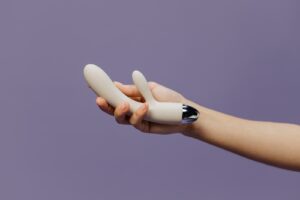For many individuals, the ears feel erogenous. Whispering naughty nothings into your partner’s ear or physically stimulating the ears with licking and massaging can heighten feelings of intimacy.
Research shows that the ears can be a powerful erogenous zone, although it’s not as common to reach orgasm with ear stimulation as with the genitals. Individuals interested in trying this may find it helpful to experiment during masturbation or with a partner.
Erogenous zones
Ears are a notoriously sensitive spot on the body that contains a lot of fine sensory nerve endings. Lightly kissing, nibbling, and licking them can turn on your partner. Caressing the ears can also be exciting, as can whispering sweet nothings or murmuring dirty talk.
For women, the earlobe is undoubtedly one of the most powerful erogenous zones. Gently caressing, kissing, stroking, and rubbing the earlobe during foreplay will give her pleasure and turn on the anticipation of what’s to come in the bedroom.
Other erogenous zones include the nape of the neck, the clavicle and the shallow depressions above it, and the lower jawline. These are all highly responsive to feather-light strokes and can be aroused with gentle massage during foreplay. Touching and stroking the clitoris, navel, and outer and inner vaginal lips (or labia) can also be arousing.
While these erogenous zones can be stimulated during partnered sex, they are also very well suited for solo masturbation. Exploring these areas of your own body during solo play can help you discover what triggers sexual arousal for you and allow you to become more in-tune with your sensual pleasures, so that you can enjoy partnered sex to its fullest. It can also be a great way to learn about your partner’s erogenous zones and what they respond to best.
Arousal
The ears are a powerful area that feels erogenous for many people. They have 25,000 nerve endings that translate sound waves into electrical impulses. These impulses then travel to the brain, where they are perceived as sound. The ears also have a role in spatial awareness. For this reason, stimulating the ears during masturbation may lead to orgasm. People can stimulate the ears by massaging, licking, and biting them. In addition, whispering into a partner’s ears can enhance feelings of intimacy and closeness.
The most common ear sex techniques involve touching, rubbing, and kissing the earlobes. However, some kinksters like to use a mouth or a tongue to massage the ear and explore the inner canal. Others enjoy tucking their partner’s hair behind the ear, as this creates an indistinct but intimate space. Other ear play involves using pillow talk to seduce a partner or to hint at things to come during intercourse.
Although many people associate orgasms with the genital area, researchers note that stimulation of erogenous zones can cause orgasm in various parts of the body. For example, a study from 2017 notes that some individuals achieve orgasms by stroking the ears. Although ear sex is often seen as taboo, it can be safe and enjoyable when it is used in a healthy, respectful relationship.
Stimulation
Ear sex is an underrated way to spice up a romantic night. A simple whisper of naughty pillow talk can create an intimate connection and stimulate the ears’ hypersensitive nerve endings. For individuals who are more adventurous, massaging the ears or gently biting them can increase sexual arousal. Additionally, tucking a person’s hair behind their ear can feel like a gentle kiss.
Although the exact science behind erogenous zones is not clear, research indicates that stimulating the ears can lead to orgasm for many people. Stimulation of the genital area also enhances sexual arousal, but it is not the only path to an orgasm. Individuals who are interested in trying ear play should first experiment with different sensations independently or with a trusted partner.
Studies on otoacoustic emissions have shown that there are gender differences in the auditory brainstem response. This is likely due to the difference in estrogen levels between females and males. In addition, the right ears of males have more spontaneous otoacoustic emissions and click-evoked otoacoustic emissions than left ears.
Gender differences in ear responses also occur in pathological conditions, such as middle-ear cholesteatoma. In these cases, sex hormones stimulate proliferation of middle-ear cholesteatoma keratinocytes. However, further research is needed to determine the precise mechanism by which sex hormones affect auditory responses. This information may help otologists recognize and treat these conditions.
Orgasm
Although most people think of genital stimulation as the most reliable way to reach orgasm, stimulating other erogenous zones may also lead to sexual pleasure. In particular, ear play can lead to orgasm for many individuals. The ears are sensitive and receptive to physical stimulation, and the sound of a partner’s breath and pillow talk can also stimulate the ear nerves. The ears can be massaged with hands, licked, bit, manipulated, and even kissed. The outer ear is particularly responsive to gentle manual touch, while the inner ear is a playground for nibbles and suction.
The ears are especially receptive to sexual pleasure because of their role in spatial awareness. Stimulating the ears with a partner while engaging in oral, facial, and other sexual activities can increase feelings of closeness and intimacy. Whispering and whispered words can enhance feelings of arousal, and music or nature sounds may add to the experience.
While most ear sex is not as intense as PIE (penis in ear) sex, it can be incredibly satisfying for some kinksters. Most ear sex is about tugging, rubbing, and licking the ears; it’s not about inserting a dick in the ear canal or blasting semen into the ear. For those who are curious about ear play, an open mind and respectful, sensual relationships are key.
See Also:






